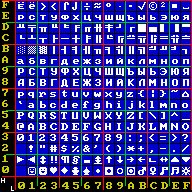This article needs additional citations for verification. (April 2015) |

In computing, a nibble[1] (occasionally nybble, nyble, or nybl to match the spelling of byte) is a four-bit aggregation,[1][2][3] or half an octet. It is also known as half-byte[4] or tetrade.[5][6] In a networking or telecommunications context, the nibble is often called a semi-octet,[7] quadbit,[8] or quartet.[9][10] A nibble has sixteen (24) possible values. A nibble can be represented by a single hexadecimal digit (0–F) and called a hex digit.[11]
A full byte (octet) is represented by two hexadecimal digits (00–FF); therefore, it is common to display a byte of information as two nibbles. Sometimes the set of all 256-byte values is represented as a 16×16 table, which gives easily readable hexadecimal codes for each value.
Four-bit computer architectures use groups of four bits as their fundamental unit. Such architectures were used in early microprocessors, pocket calculators and pocket computers. They continue to be used in some microcontrollers. In this context, 4-bit groups were sometimes also called characters[12] rather than nibbles.[1]
- ^ a b c Cite error: The named reference
Intel_1974_MCS-40was invoked but never defined (see the help page). - ^ Cite error: The named reference
Hall_1980was invoked but never defined (see the help page). - ^ Cite error: The named reference
Warren_2013was invoked but never defined (see the help page). - ^ Cite error: The named reference
esrwas invoked but never defined (see the help page). - ^ Cite error: The named reference
Carr_1959was invoked but never defined (see the help page). - ^ Cite error: The named reference
Speiser_1965was invoked but never defined (see the help page). - ^ Cite error: The named reference
Puzman_2012was invoked but never defined (see the help page). - ^ Cite error: The named reference
Horak_2007_Websterswas invoked but never defined (see the help page). - ^ Cite error: The named reference
Brewster_1994was invoked but never defined (see the help page). - ^ Cite error: The named reference
Courbis_1989was invoked but never defined (see the help page). - ^ Cite error: The named reference
Intro_CPP_1997was invoked but never defined (see the help page). - ^ Cite error: The named reference
Intel_1973_MCS-4was invoked but never defined (see the help page).